Este post também está disponível em:
Português
English
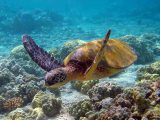
Coconut Coast is the lush Green Line in Bahia.
The Coconut Coast covers the municipalities of Camaçari, Conde, Entre Rios, Esplanada, Jandaíra, Lauro de Freitas and Mata de São João, it is on the Costa dos Coqueiros that the Praia do Forte, the Porto Sauípe and the Parque das Dunas in Mangue Seco.
Coconut Coast is served by the Deputado Luís Eduardo Magalhães International Airport, from where the region is reached by the ecological route called Linha Verde, parallel to the coast.
Coconut Coast is famous for its coconut trees, which adorn the almost 200 kilometres of beaches, as well as rivers, lagoons, small waterfalls and mangroves that help to balance the marine fauna.
This region has electricity, drinking water, sanitation and telecommunications services in several locations.
Praia do Forte is located on the Green Line, 50 km from Salvador. Lauro de Freitas is located 22 km from Salvador.
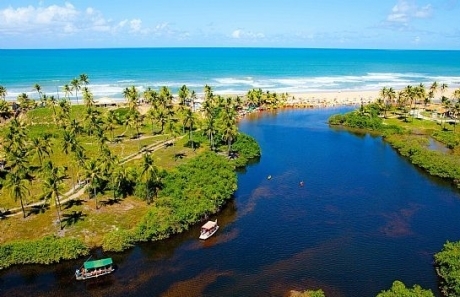

Litoral Norte da Bahia
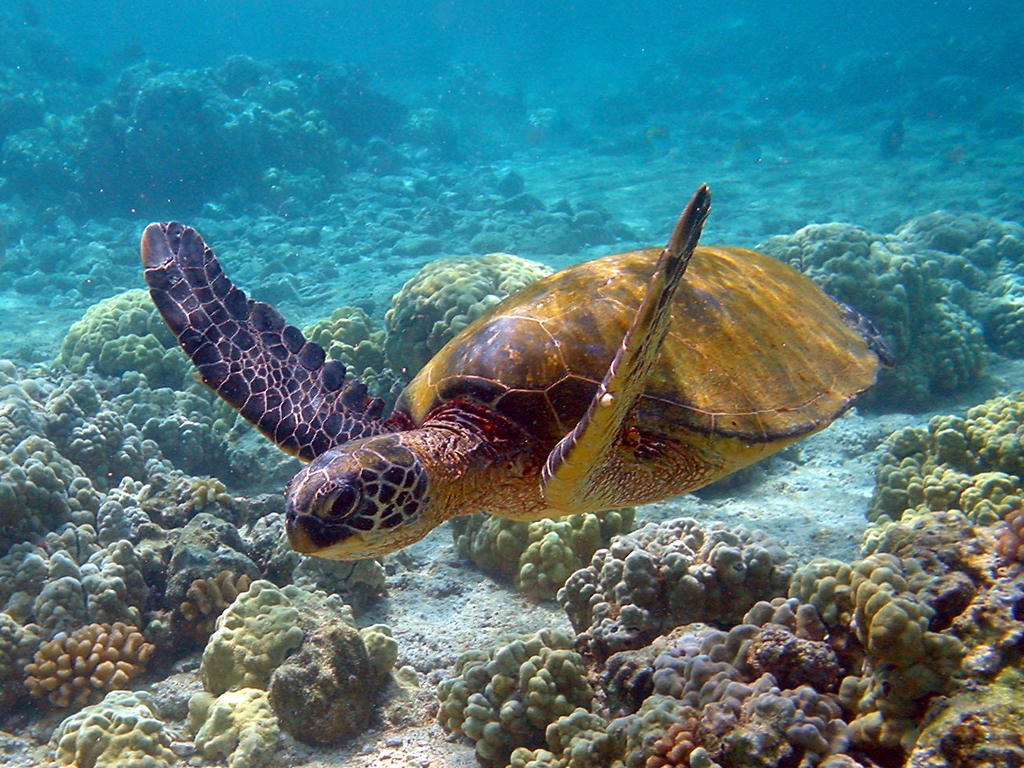
Costa dos Coqueiros - Reportagem
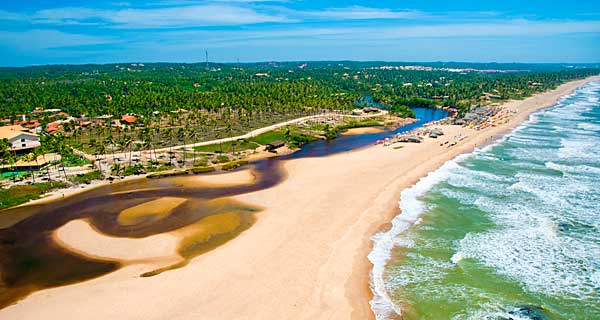
Imbassaí na Bahia
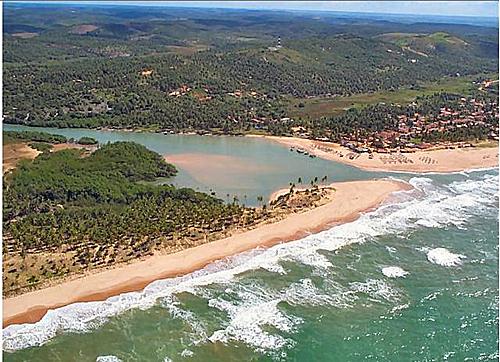
Conde na Bahia
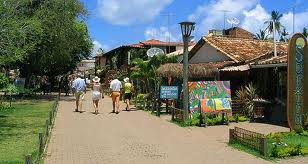
Praia do Forte na Costa dos Coqueiros
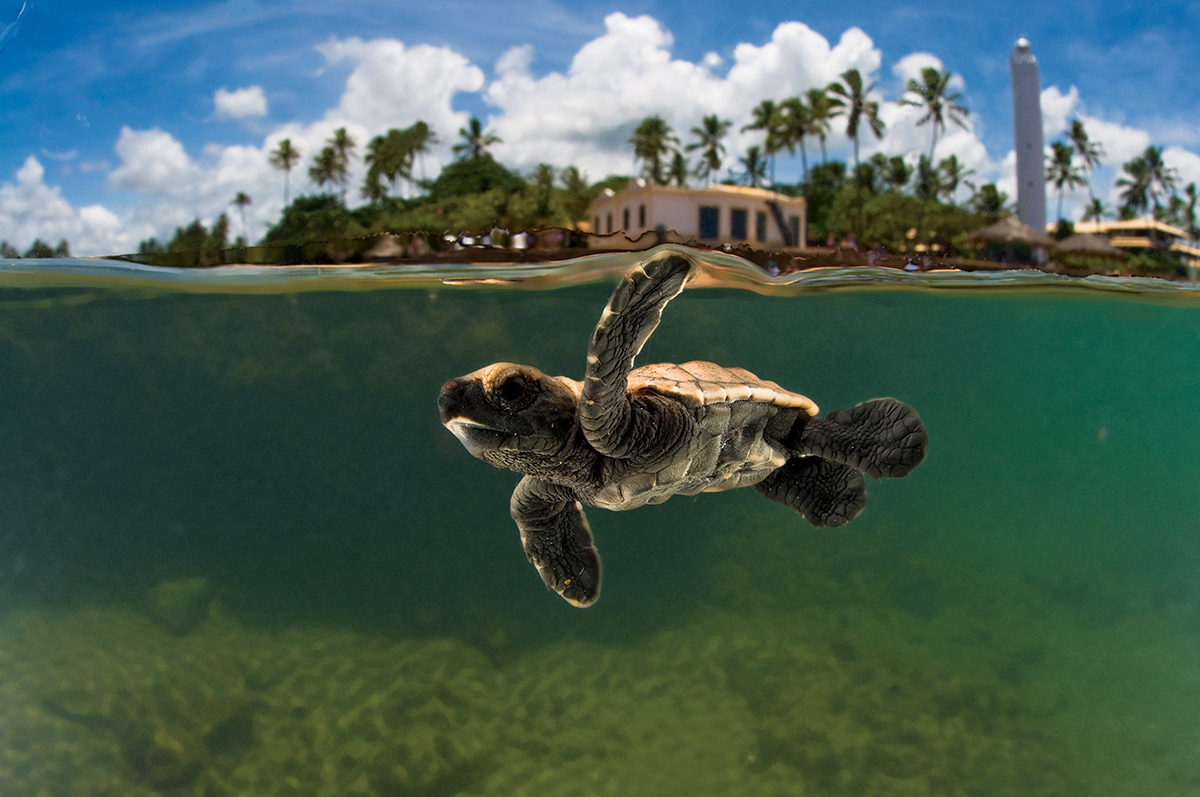
Praia do Forte - Reportagem
The region of the coast of Bahia that borders the so-called Estrada do Coco was named Costa dos Coqueiros.
The Coconut Coast is immediately north of the Baía de Todos os Santos region, where the capital Salvador is located.
The Coconut Coast is located in the municipality of Mata de São João.
The municipality of Mata de São João is home to important tourist destinations in Bahia, such as Imbassaí beach, Praia do Forte and Costa do Sauípe, which concentrates the largest number of high standard resorts on the Brazilian coast.
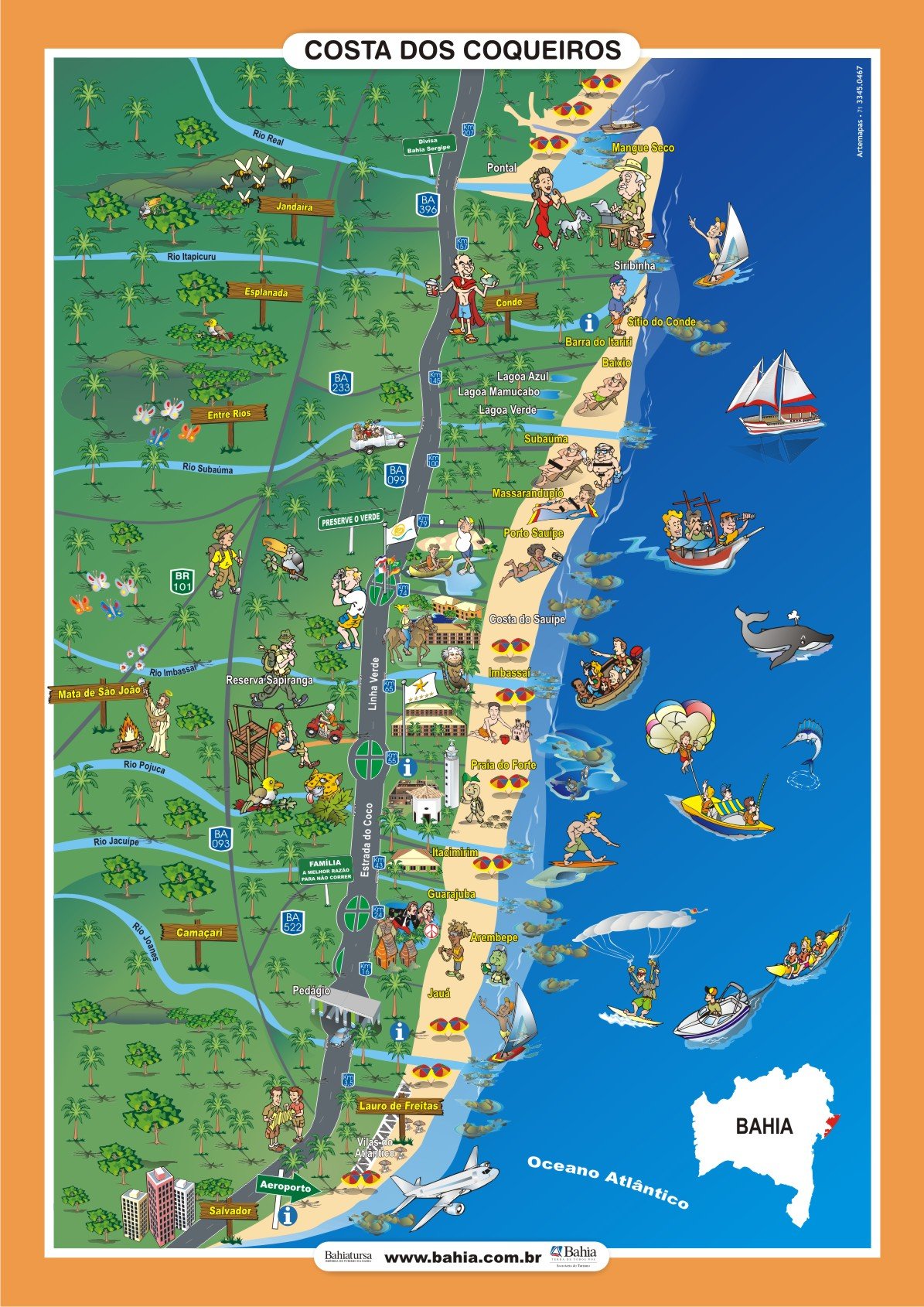
In 1993, the motorway was extended for another almost 200 km, reaching the border with Sergipe; this stretch, also totally ecological, was baptised Linha Verde (Green Line).
The BA-099 (now operated by a private concessionaire) unveiled areas of pristine natural beauty on the northern coast of Bahia.
Its route allows the socio-economic integration of several neighbouring municipalities, enabling the development of the region, especially in the leisure segment, with a range of tourist facilities that make it easier for visitors to explore the natural beauties such as flora, dunes and an extensive hydrographic network.
The beaches of the Estrada Coco provide the opportunity to enjoy the natural beauty of the region.
The beaches of Estrada do Coco offer sea bathing in calm, warm waters and almost always surrounded by natural breakwater.
Several places also have lagoons, rivers, forming stunning landscapes; part of the set of natural beauties of the region are the rivers Jacuípe, Pojuca and Joanes, the latter being an excellent point for water sports.
Tourist spots on the Coconut Coast or Costa dos Coqueiros
- Lauro de Freitas
- Ipitanga Beach – Lauro Freitas
- Buraquinho Beach – Lauro Freitas
- Vilas do Atlântico – Lauro Freitas
- Barra de Jacuípe – Camaçari
- Jandaíra
- Imbassaí – Mata de São João
- Barra do Itariri – Conde
- Tamar Project – Praia do Forte
- Garcia D’Ávila Castle – Praia do Forte
- Subaúma – Entre Rios
- Massarandupió – Entre Rios
- Terminal Turístico Mãe Mirinha do Portão
- Timeantube Lagoon – Praia do Forte
A trip along the Costa dos Coqueiros and the Green Line offers, in addition to the beaches, numerous cultural and ecological attractions for tourists.
1. Lauro de Freitas
In Lauro de Freitas on the Costa dos Coqueiros, there is no shortage of leisure options for holidaymakers.
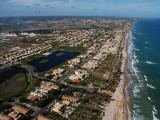
In the city, there are diverse natural beauties, with emphasis on the centres of preservation and exploration of ecotourism, which have been a source of pride.
The incentive to practice sports is a reference for the whole of Bahia and, alongside cultural tourism, is also one of the biggest attractions for visitors. Formerly Santo Amaro de Ipitanga, the city has unique leisure facilities on the entire Costa dos Coqueiros, such as the Ayrton Senna Kartodrome, the Bahia Jockey Club and the Equus Horse Club.
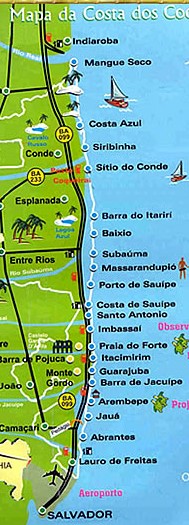
At all times of the year, surfing, windsurfing, volleyball, sand football, sailing, skateboarding, rollerblading and diving championships are common.
Fishing also has its place, especially in the Joanes and Ipitanga rivers, which bathe the municipal centre. With calm waters, they are navigable for small boats and excellent for water sports.
The preservation areas are a delight for nature lovers.
There are basically four large parks concentrated in the Rio Joanes Environmental Protection Area and in private enterprises, also of an ecological nature. Religiosity is another strong point.
The municipality has one of the largest concentrations of candomblé terreiros in Bahia (there are 66 registered institutions, along the 93 km² of area), which, combined with indigenous rituals and traditional esoteric walks on the beaches, such as the Full Moon, set the tone for local religious syncretism.
2. Praia de Ipitanga | Lauro Freitas
Initially sought after for its good waves, Ipitanga has become, in a few years, the most popular beach in all of Greater Salvador.
Located on the exact border between the capital and the municipality of Lauro de Freitas, Ipitanga, during the weekends, is crowded with visitors.
This demand is explained by the great local infrastructure, which has inns, restaurants and very sophisticated beach huts. In addition to these attributes, the beach is the great “point” of young people, who usually settle in a small stretch called “Aleluia”.
The bathing is delicious, since at some points, natural pools of warm water appear.
3. Buraquinho Beach | Lauro Freitas
Its sands are adorned with coconut trees and interesting rock formations.
On the south side, the sea has strong waves and is best for swimming during the ebb tide.
To the north, it meets the mouth of the Joanes River, in a stretch of sea / river excellent for good jet-ski manoeuvres and kayak rides.
As Buraquinho only entered the tourist circuit a few years ago, its infrastructure is still small.
4. Vilas do Atlântico | Lauro Freitas
Within Lauro de Freitas, about 5km after Salvador International Airport, is Vilas do Atlântico.
Located in a gated community, with complete infrastructure and security, the beautiful beach, in its 6 km of extension, has as its major mark its vast coconut grove and very white sands.
Its success is explained not only by its beauty, but also by the fact that it is a practical alternative to escape from the busy routine of the capital. This is Vilas do Atlântico, one of the most popular beaches on the North Coast, due to the varied leisure options it offers: surfing, sand football, volleyball, frescobol, as well as plenty of shade and fresh water.
Well-equipped stalls serve everything from traditional beach snacks (fried fish, crab, lambreta and various broths) to exquisite international cuisine, including sushi and sashimi.
The beer is always cold and the traditional caipirinha has a guaranteed outlet.
The condominium also has flats, inns, hotels, shopping malls, cinema and restaurants, for those who want to extend the programme.
5. Barra de Jacuípe | Camaçari
Barra de Jacuípe on the Costa dos Coqueiros is located approximately 58 km from Salvador, the area covers a village of the same name, where fishermen and people who work in the region reside. Jacuípe is very popular for the summer, since it has many houses in well-structured condominiums.
The meeting of the Jacuípe River with the sea provides one of the most beautiful landscapes of the North Coast. Dunes, native coconut groves, reefs and quiet beaches complete the attractions.
A stunning landscape, especially at sunset, and the calm waters of the river are the perfect stage for water sports; jet-skis are often present in its waters; fishing is also a frequent practice there.
In the small harbour it is possible to rent a canoe for a trip on the river or simply to cross to a desert island formed by the Capivara and Jacuípe rivers and the sea.
The place is still very good for camping. Attention only to the sea, which, during high tide, has strong currents and waves.
6. Imbassaí | Mata de São João
It was the first inhabitants who nicknamed the place Imbassaí, which in Tupi means “path of the river”. It could not be otherwise, as there are many freshwater passages that flow in cascades and rapids, parallel to the dunes, on their way to the sea.
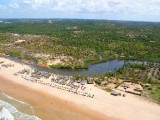
Located in the Conservation Unit – Green Line, the municipality is 63km from Salvador and just 13km ahead of Praia do Forte within the city of Mata de São João.
It gathers attractions for those seeking ecological and adventure tourism, with special spots for rafting and sandboarding.
Imbassaí, on the Costa dos Coqueiros, has recently become a centre for ecological tourism with the opening of the Green Line.
After the construction of this road, which connects all the tourist spots of the Costa dos Coqueiros, the primitive village began to be prepared with hotel and service infrastructure, gaining, every day, new equipment to welcome and better serve visitors. The inns, bars and restaurants are spread over an area of 3km², between cashew trees, coconut groves and forest.
The 6 km of beaches are bordered by high dunes, which hide the Imbassaí River, famous in the region for offering a peaceful and invigorating freshwater bath.
The stalls are located on the strip of sand between the beach and the river, offering cold drinks and snacks of fried fish and seafood, as well as the traditional acarajé, on the trays of the baianas.
Access to the beaches is only possible for pedestrians, as the rivers that border them form a natural barrier to vehicles, which increases the tranquility of the village.
7. Jandaíra
A sesmaria donated in 1543 to the governor-general, Luís Brito de Almeida, gave rise to the current municipality of Jandaíra. The primitive settlement arose around a chapel built in honour of Our Lady of Abadia in the 18th century.
In 1718, it was elevated to a district and, in 1728, to a municipality, with the name Vila de Abadia. In 1880, its seat was transferred to the village of Cachoeira, receiving then the name of Cachoeira da Abadia.
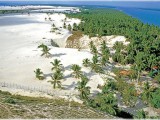
In 1927 it was renamed Jandaíra, a name that means “Honey Bee”. Extinct twice, in 1931 and 1943, it was finally elevated to a city in 1944. Jandaíra is a coastal municipality on the Costa dos Coqueiros, located on the border with the state of Sergipe, separated from it by the Rio Real.
Jandaíra on the Costa dos Coqueiros is 202 km from Salvador.
Jandaíra is the second largest producer of coconut in Bahia and a major producer of passion fruit; the municipality has as main tourist attractions the district of Mangue Seco (246 km from Salvador); Praia da Costa Azul, semi-deserted, with warm and calm waters; Praia dos Coqueiros, 6 km long, with coconut trees and mobile dunes that reach 35 metres high; Rio Real, a tributary of the Rio Piauí, with clean and warm waters, favourable for nautical sports and which bathes the Environmental Protection Area of Mangue Seco; Cachoeira do Itanhi, a fall of the Rio Real, favourable for bathing; Fonte da Garunga, with clear waters that flow from a cave surrounded by Atlantic Forest.
Mangue Seco is a fishing village geared towards leisure and adventure tourism, with buggy rides through the dunes, schooner and speedboat rides on the Real and Itapicuru rivers, which form the region’s mini-bay.
A beautiful and cosy place where contact with nature is intense, so it is a good place to rest and enjoy nature. Mangue Seco was the setting for the filming of Tieta do Agreste, a film directed by Cacá Diegues.
8. Barra do Itariri | Conde
Bahia, known for the best carnival in the world, hides small villages where tranquillity and peace are always present. 168 kilometres from Salvador, Barra de Itariri on the Costa dos Coqueiros is a small fishing village that still retains all the beauty and simplicity of its rustic and native lifestyle.
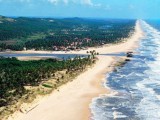
The place is a great option for those who want to get away from the hustle and bustle of the city, enjoying nature and its beautiful scenery, including during Carnival.
Enjoying the sea and its benefits is one of the main attractions for those who visit this village, which brings together rivers, mangroves, dunes, lagoons and lots of Atlantic forest in its landscape.
The name Barra do Itariri has an indigenous origin and means small stone or stones that roll. Leaving aside the controversy of the name, the consensus is the striking beauty of this place.
The landscape is enchanting and one of its greatest attractions is the meeting of the river with the sea, when the Itariri River, which winds through the mangrove, goes on its way to the sea, making a graceful curve and soon mixing with each other in perfect harmony. Isolated by the waters, the dunes stand out and, dotted with coconut palms, complete the spectacle.
At low tide you can reach the dunes on foot and stroll along the fine sands.
Another option is when the tide is high, making it possible to take boat trips and practise water sports such as fishing, rowing, canoeing and swimming. Its waters, always warm and clear, are an irresistible invitation to bathe. You can also enjoy other pleasures in the river, such as being in the flavour of the currents, which offer a feeling of well-being.
This is also where the beach huts made of wood and straw are concentrated, where tasty seafood dishes, specialities of the region and drinks made from tropical fruits such as mangaba, cashew, acerola and cajá are served. A delight for those who like to enjoy good Bahian cuisine and all these delicacies that the sea has to offer.
And if you still have breath and want to enjoy a little more of this naturalistic environment, you can visit the lighthouse that sits on top of a hill and holds the best view of Barra do Itariri.
From the top, you can see the coconut trees and the sea, in the background, with its shades of green and blue – one of the most beautiful landscapes of the Bahian coast. The place is also perfect for enjoying the sunset.
To welcome visitors, Barra do Itariri offers a wide range of accommodation, from simple, cosy lodgings to luxurious environments. There is the option of simple inns, hotels, houses for rent and even a resort.
9. Projeto Tamar | Praia do Forte
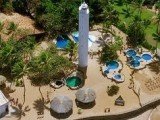
The Tamar Project was created in the 1980s to study and protect sea turtles on the Brazilian coast.
There are 21 bases spread across the country, with the one in Praia do Forte on the Costa dos Coqueiros being the most interesting and well-equipped, with a visitor centre, tanks and aquariums with turtles and fish, a video room, shop and restaurant.
The Tamar Project has 21 bases spread across the country.
Between December and February it is possible to follow the biologists releasing newborn turtles on the sand.
10. Garcia D’Ávila Castle | Praia do Forte
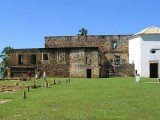
The Garcia D’Ávila Castle, or the Tower, is located near Praia do Forte.
It is the first large Portuguese building of military residential architecture in Brazil, with characteristics of a medieval castle.
Its builder, the Portuguese Garcia D’Ávila, arrived in Bahia in the position of royal steward and became one of the largest landowners in history, with 129 farms occupying 800,000 square kilometres, which is equivalent to one tenth of the current Brazilian territory.
The castle was built by the Portuguese Garcia D’Ávila.
Unfortunately in the 19th century, it was already a great ruin; it was listed by IPHAN, and today it is under restoration.
11. Massarandupió | Entre Rios
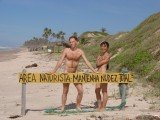
The sea is ideal for bathing at all stages of the tide, especially during the ebb tide, when the waves practically disappear.
The strip of sand, which is part of the environmental protection area, is much sought after by sea turtles during the spawning period.
The spectacle is due to the landscape, surrounded by high dunes of white sand, full of coconut trees. With the summer sun, the beach becomes a true oasis.
The spectacle is the landscape.
At the end of the road, between the village and the beach, there are tents, restaurants and bars, ideal for moments of comfort and total delight, along with delicious dishes based on seafood; behind the dunes there is a lake, bordered by a large grassy area, excellent for wild camping.
12. Subaúma | Entre Rios
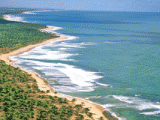
The long strip of sand is completely taken over by beautiful coconut trees, and the place is completely urbanised, with beach huts, restaurants and inns.
The fishing village has a natural harbour and good tourist infrastructure. The highlight of the place is the Mirante do Cruzeiro, which offers a panoramic view of the entire region.
The fishing village has a natural harbour and good tourist infrastructure.
Both the beach and the lagoons of the region are great options for water sports, such as kayaking, windsurfing and jet-skiing; during the summer some important sports competitions are held.
13. Tourist Terminal Mãe Mirinha do Portão
The name is in honour of Altamira Maria da Conceição Souza, a Mother-of-Saint of international renown and fame, who deserved mentions in several newspapers and magazines of great circulation and was also quoted by Jorge Amado.
One of the main postcards of the city of Lauro de Freitas, the Terminal offers an infrastructure of restaurants with typical regional cuisine, German dishes, pizzerias and homemade delicacies; you can also take a boat trip along the Joanes River, bound for Buraquinho Beach.
The terminal also houses a vegetable garden, a beautiful garden, craft shops and the Reference Centre of Afro-Brazilian Culture.
In March, the festival in honour of St. Francis of Assisi takes place, with a procession of the faithful that departs from the Terminal and follows the pilgrimage to Buraquinho.
14. Lagoa Timeantube | Praia do Forte
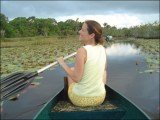
The calm waters of the Iaçu River spread out on the floodplain and are an invitation for a pleasant kayak or boat ride, enjoying the surrounding nature.
Birds of the most varied species contemplate the visitor as they cut the beautiful sky of an endless blue. Woodpeckers, jaçanãs, hummingbirds and mangrove parrots are a constant presence among the more than 245 birds already catalogued in the region.
The birds of the most varied species contemplate the visitor while cutting through the beautiful sky of an endless blue.
Bahia.ws is the largest tourism and travel guide to Bahia and Salvador.
Tourism and Travel Guide of the Coconut Coast in Bahia.



















